Deep immunophenotyping reveals circulating activated lymphocytes in individuals at risk for rheumatoid arthritis
- PMID: 40091833
- PMCID: PMC11910230
- DOI: 10.1172/JCI185217
Deep immunophenotyping reveals circulating activated lymphocytes in individuals at risk for rheumatoid arthritis
Abstract
Rheumatoid arthritis (RA) is a systemic autoimmune disease currently with no universally highly effective prevention strategies. Identifying pathogenic immune phenotypes in at-risk populations prior to clinical onset is crucial to establishing effective prevention strategies. Here, we applied multimodal single-cell technologies (mass cytometry and CITE-Seq) to characterize the immunophenotypes in blood from at-risk individuals (ARIs) identified through the presence of serum antibodies against citrullinated protein antigens (ACPAs) and/or first-degree relative (FDR) status, as compared with patients with established RA and people in a healthy control group. We identified significant cell expansions in ARIs compared with controls, including CCR2+CD4+ T cells, T peripheral helper (Tph) cells, type 1 T helper cells, and CXCR5+CD8+ T cells. We also found that CD15+ classical monocytes were specifically expanded in ACPA-negative FDRs, and an activated PAX5lo naive B cell population was expanded in ACPA-positive FDRs. Further, we uncovered the molecular phenotype of the CCR2+CD4+ T cells, expressing high levels of Th17- and Th22-related signature transcripts including CCR6, IL23R, KLRB1, CD96, and IL22. Our integrated study provides a promising approach to identify targets to improve prevention strategy development for RA.
Keywords: Arthritis; Autoimmunity; Bioinformatics; Immunology; Rheumatology.
Figures







Update of
-
Deep immunophenotyping reveals circulating activated lymphocytes in individuals at risk for rheumatoid arthritis.bioRxiv [Preprint]. 2023 Jul 4:2023.07.03.547507. doi: 10.1101/2023.07.03.547507. bioRxiv. 2023. Update in: J Clin Invest. 2025 Mar 17;135(6):e185217. doi: 10.1172/JCI185217. PMID: 37461737 Free PMC article. Updated. Preprint.
References
MeSH terms
Substances
Grants and funding
- UM2 AR067678/AR/NIAMS NIH HHS/United States
- P30 AR072577/AR/NIAMS NIH HHS/United States
- P30 AR070253/AR/NIAMS NIH HHS/United States
- R01 AR080659/AR/NIAMS NIH HHS/United States
- UH2 AR067688/AR/NIAMS NIH HHS/United States
- UH2 AR067689/AR/NIAMS NIH HHS/United States
- UH2 AR067677/AR/NIAMS NIH HHS/United States
- UH2 AR067679/AR/NIAMS NIH HHS/United States
- R01 AR077607/AR/NIAMS NIH HHS/United States
- UH2 AR067685/AR/NIAMS NIH HHS/United States
- UL1 TR002541/TR/NCATS NIH HHS/United States
- UC2 AR081032/AR/NIAMS NIH HHS/United States
- UH2 AR067681/AR/NIAMS NIH HHS/United States
- P30 AR073750/AR/NIAMS NIH HHS/United States
- R01 AR063759/AR/NIAMS NIH HHS/United States
- UH2 AR067690/AR/NIAMS NIH HHS/United States
- UM1 TR004399/TR/NCATS NIH HHS/United States
- UH2 AR067694/AR/NIAMS NIH HHS/United States
- UH2 AR067676/AR/NIAMS NIH HHS/United States
- UH2 AR067691/AR/NIAMS NIH HHS/United States
LinkOut - more resources
Full Text Sources
Medical
Research Materials

